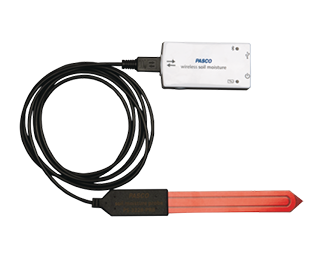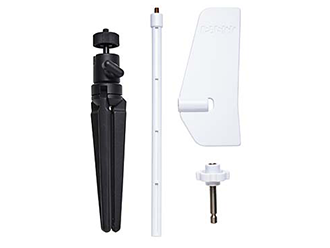Description
The Wireless Soil Moisture Sensor measures the volumetric water content (%VWC) of soil, reporting data in real time or storing it onboard the sensor’s memory for long-term experiments. Durable and easy to use, the Wireless Soil Moisture Sensor is the perfect tool for monitoring controlled experiments in the classroom and long-term experiments outdoors. From experiments in evaporation and soil composition to water consumption and plant competition, the Wireless Soil Moisture Sensor makes it easy for students to investigate a wide array of topics through real-time or long-term data collection.
To use the sensor, dig a trench a few inches below the ground’s surface and place the sensor’s spear-shaped portion in the soil. Be sure to pack the soil tightly around the sensor for best accuracy. After use, the surrounding soil should be loosened to reduce the risk of damaging the sensor’s cord.
Features
- Collect and display data in real time within PASCO Capstone or SPARKvue software
- Automate data collection for hours, days, or weeks with Logging Mode
- Bluetooth connectivity enables use in the classroom, lab, or field
- Supports use of GPS data from a mobile device for GIS mapping activities
- Selectable calibrations for predominantly sandy soils, clay soils, and loamy soils
Applications
- Monitor soil moisture content to control irrigation in greenhouses and gardens
- Measure changes in soil moisture over time due to evaporation and/or plant uptake
- Investigate the effects of different land covers on soil moisture retention in xeriscaping
- Determine the optimum soil moisture content required for plant species to germinate
- Investigate the relationship between soil moisture content and heat stress in plants
- Explore the effect of moisture on mold growth in food sources
- Combine with GPS data from a mobile device and stream soil moisture data to an online map for GIS activities
How It Works
The Wireless Soil Moisture Sensor determines the percent water content by volume of soil by measuring the dielectric constant of the space around the blade-shaped capacitor. An electric field generated by the sensor responds to the capacitance of the surrounding space and uses the response to calculate the soil’s percent water content per volume.
Liquid water has a uniquely high capacitance, making it the predominant contributor to the sensor’s measurement. The sensor comes factory-calibrated for soils with discreet values of volumetric water content and outputs readings in percentage of total space filled. Accurate readings range from 0%, in which there is little to no moisture in a dried sample, to 45%, in which all the available pore space within the soil is saturated with water. For a % saturation reading, divide the value by 45.
The sensor has been calibrated to support analyses in 3 of the predominant soil types: sandy soils, clay soils, and loamy soils. If you are unsure of your soil type, select the intermediate calibration, loamy soil which works for the broadest conditions.
Product Specifications
| Sensor range | 0 to 45% water by volume |
| Sensor accuracy | ±5% |
| Resolution | 0.1% |
| Power | 3 mA at 5 V DC |
| Operating Temperatures | -40 to 60°C |
| Probe cable length | 2m |
Battery & Logging
| Data capacity | > 55,000 data points |
| Battery | 3 – 5 days on single charge depending on sample rate |
| Battery Type | Rechargeable coin cell via USB micro |
1 Minimum # of data points with all measurements enabled, actual results depend on enabled measurements.
2 Continuous use in a connected state until battery failure, actual results will depend on sample rate, active measurements, and battery condition.
3 Logging until battery failure, actual results will depend on sample rate, active measurements, and battery condition.
* Normal classroom use is the sensor in active use for 20min/lab for 120 lab periods/yr.
Experiment Library
Perform the following experiments and more with the Wireless Soil Moisture Sensor.
Visit PASCO’s Experiment Library to view more activities.


